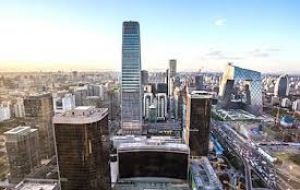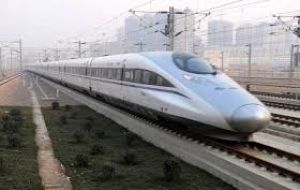MercoPress. South Atlantic News Agency
Beijing sinking because of excessive pumping of groundwater: 11cms per year
 Beijing sits in a dry plain where groundwater has accumulated over millennia. As wells are drilled and the water table drops, the underlying soil compacts
Beijing sits in a dry plain where groundwater has accumulated over millennia. As wells are drilled and the water table drops, the underlying soil compacts  Satellite imagery study finds that the entire city is sinking but subsidence is most severe in Chaoyang district with skyscrapers, ring roads and other development.
Satellite imagery study finds that the entire city is sinking but subsidence is most severe in Chaoyang district with skyscrapers, ring roads and other development.  Tens of thousands of water wells are thought to exist in and around Beijing, many of them used in farming and landscaping.
Tens of thousands of water wells are thought to exist in and around Beijing, many of them used in farming and landscaping.  The study on Beijing’s subsidence has been published in the peer-reviewed journal Remote Sensing and is based on InSAR, a radar that monitors land elevation
The study on Beijing’s subsidence has been published in the peer-reviewed journal Remote Sensing and is based on InSAR, a radar that monitors land elevation  To prevent derailments a 2015 study recommended that China ban new water wells near completed high-speed rail lines.
To prevent derailments a 2015 study recommended that China ban new water wells near completed high-speed rail lines. China’s capital is known for its horrendous smog and occasional sandstorms. Yet one of its major environmental threats lies underground: Beijing is sinking. Excessive pumping of groundwater is causing the geology under the city to collapse, according to a new study using satellite imagery that reveals parts of Beijing – particularly its central business district – are subsiding each year by as much as 11 centimeters.
The authors of the study warn that continued subsidence poses a safety threat to the city of more than 20 million, with “a strong impact on train operations” one of the predictions.
The study on Beijing’s subsidence has been published in the peer-reviewed journal Remote Sensing and is based on InSAR, a type of radar that monitors land elevation changes. It was written by a team of seven researchers, including three who explained their findings to The Guardian: Chinese academics Chen Mi and Li Xiaojuan, and Spanish engineer Roberto Tomas.
“We are currently carrying out a detailed analysis of the impacts of subsidence on critical infrastructure (eg high-speed railways) in the Beijing plain,” they said in an email. “Hopefully a paper summarizing our findings will come out later this year.”
Beijing sits in a dry plain where groundwater has accumulated over millennia. As wells are drilled and the water table drops, the underlying soil compacts, much like a dried-out sponge.
The study finds that the entire city is sinking but the subsidence is most pronounced in Beijing’s Chaoyang district, which has boomed since 1990 with skyscrapers, ring roads and other development. The researchers say the uneven nature of the subsidence in some areas poses risks to buildings and other infrastructure.
Tens of thousands of water wells are thought to exist in and around Beijing, many of them used in farming and landscaping. The state has regulatory power over installation of wells but is inconsistent in applying it, according to one leading Chinese environmentalist.
“There are some rules but the enforcement is doubtful,” said Ma Jun, director of the Institute of Public and Environmental Affairs in Beijing. Ma said he wasn’t surprised subsidence was relatively high in the Chaoyang district given its rapid growth of recent decades. He expected it to keep moving east as the city sprawled in that direction.
In 2015 China inaugurated a mega-engineering project aimed at mitigating Beijing’s water crisis. The state completed construction of the South-North Water Diversion, a US$ 75bn, 2,400km network of canals and tunnels, designed to divert 44.8bn cubic meters of water to the capital..
Even before the canal began delivering water, Beijing was easing up on some groundwater pumping. In January of 2015 the Chaoyang district announced plans to phase out 367 water wells, reducing the use of 10m cubic meters of underground water.
Experts say it is still too early to know if the canal’s water deliveries will help recharge the aquifer and slow Beijing’s rate of subsidence. In the meantime concerns about impacts to buildings and rail systems continue. To prevent derailments a 2015 study recommended that China ban new water wells near completed high-speed rail lines..
Other cities around the world are experiencing subsidence caused by excessive water pumping or other factors. Mexico City is sinking by up to 28cm a year and Jakarta is subsiding at a similar rate. Bangkok is dropping annually by as much as 12cm, similar to Beijing, according to the Remote Sensing researchers.




Top Comments
Disclaimer & comment rules-

-

-

Read all commentsAre the Chinese getting that “ sinking feeling ”?
Jun 26th, 2016 - 06:40 am 0Maybe this is the reason they're building so many 'artificial' islands...so they can move the population before they're 6 ft under water.
Jun 26th, 2016 - 11:02 am 0Oh dear, never mind eh?
Jun 27th, 2016 - 11:21 am 0Couldn't happen to a nicer bunch of crooks: I pity the poor sods who have to do their 'bidding' (or else).
Commenting for this story is now closed.
If you have a Facebook account, become a fan and comment on our Facebook Page!